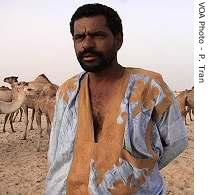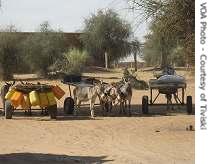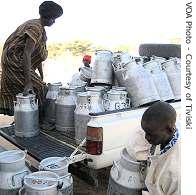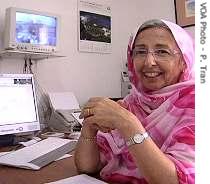2007年VOA标准英语-Camel Milk Transforms Mauritania's Herding Life(在线收听)
Nouakchott, Mauritania
20 August 2007
Camel milk has been honored as a gourmet food by Italy, as a poverty reducer by the United Nations and as a blessing by those who work with camels, for its healing power. A British physicist convinced Mauritanians, two decades ago, to part with their animals' sacred milk. Since then, camel cash has changed Mauritania's nomadic lifestyle. Advocates say, if camels could earn respect outside the desert world, they could change even more. Phuong Tran brings us this report from Nouakchott, Mauritania.
 |
| Amadou Gouh with his camels |
He says he started with five camels his father gave him. Now, he has 155 of them, worth $80,000. The herder says he has become rich through the grace of God, and his camels' milk.
 |
| Herders deliver milk, Rosso, Mauritania |
Tiviski's president says about 1,000 herders deliver milk, twice a day.
Nancy Abeiderrahmane is a British nuclear physicist who came up with the idea for a milk business, three decades ago. She did not understand why Mauritanians imported milk when they had milk-producing animals, next door in the desert.
But it was a long slow start.
|
|
| Nancy Abeiderrahmane |
But slowly, the herders agreed to sell their animals' milk. Last year, they sold 400,000 tons to Tiviksi, at almost 60 cents a kilogram.
The United Nations Food and Agricultural Organization has found camel milk to be a good way to decrease not only widespread poverty in the desert, but also malnutrition.
Camels can produce milk, even under harsh conditions, which can feed local communities.
Israeli physiology professor Reuven Yagil wanted to find out camels' secret.
"I took the camel as the supreme animal, surviving in the desert, to see what allows it to go without water, very poor food, in the heat of the sun," said Yagil. "And, then I came around to see how it could produce food when all the other food animals are dying."
Three decades later, he is still traveling around the world to research and promote camel products. Yagil says camels' immune system is close to humans, which he says makes its milk a potential cure for anything from allergies to autism.
Researchers near desert communities in India and the Middle East have long published studies about camel milk as a promising aid in the fight against allergies, diabetes and even face wrinkles.
 |
| Camel herders making daily deliveries at Tiviski's plant |
Physiologist Yagil says people far from the desert do not see camels' worth.
"The interest is growing, but it has not reached a stage where we can put it on the market. There is still a lot of mysticism," added Yagil. "There is a feeling a camel is an ancient animal. It has got no value anymore in this world and that has to be conquered first."
Even if people do not accept camel milk as a medical cure-all, Yagil says it simply tastes good. In addition to milk, some camel products on the market include camel chocolate, cheese, ice cream and yogurt.
According to the Food and Agricultural Organization, there are about 20 million camels in the world, with most believed to be in Somalia. Most camel milk comes from Somalia and Saudi Arabia.
